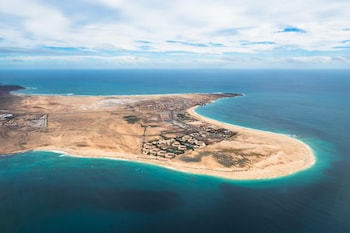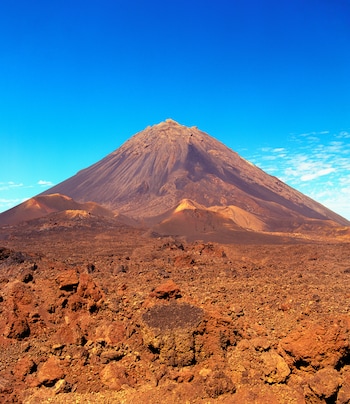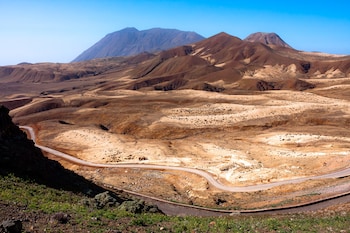As a holiday destination, Cape Verde has plenty to recommend it. It’s a year-round sun spot with alluring beaches, volcanic hiking routes, and a lively music scene, not to mention direct flights from the UK at under six hours, and no time difference – so no jet lag to contend with.
These draws would appear to be common knowledge. Indeed, it seems that just about everyone is searching for it online.
According to the Global Travel Search Index, which ranks the holiday destinations that have shown the greatest increase in Google search interest over the past 12 years, Cape Verde takes the top spot – with a spike of more than 3,000 per cent since 2004. Earlier this year the islands were named the second most searched-for spot on Earth for Britons, sandwiched between the perennial city break favourites of Barcelona and Amsterdam.
Not that all those searches are translating into visits. The latest stats on tourism reveal that the Atlantic archipelago – covering around 1,500 square miles – only welcomed 644,000 tourists in 2016. By comparison Tenerife, covering 785 square miles, had 5.7 million tourists that year.
A spike in Google searches
True Luxury Travel, which assembled the Global Travel Search Index, found that Cape Verde had the biggest increase in Google searches since 2004 worldwide (looking at 2017 alone, it came in second, after Barcelona).
To accurately assess rises and falls in annual searches, Google Trends issues various geographical locations with a “score” based on the overall volume in searches, taking into account how many people have been using Google over time.
In 2004, Cape Verde’s score was 23, but by 2016, it was 713 – a 3,000 per cent rise. It was followed by the United Arab Emirates (a 681 per cent spike over 12 years), the Philippines (a 276 per cent rise), Pakistan (a 162 per cent rise) and Nigeria (a 145 per cent rise).
Which destinations saw the biggest drop in Google searches?
Libya saw the most dramatic dip in search interest for holidays there (an 88.8 per cent drop over 12 years), for obvious reasons, having descended into civil war six years ago. The Foreign Office continues to advise against all travel there, and Tripoli’s International Airport has been closed since 2014.
After Libya it was Tunisia (a 88.1 per cent drop), Paraguay (down 86 per cent), Somalia (a 85.9 per cent drop) and Iraq (a 88.5 per cent fall).
Have visitor numbers in Cape Verde actually been climbing?
Yes, just not quite so dramatically. Cape Verde welcomed 644,000 tourists in 2016, a 13.6 per cent rise from the previous year.
Henry Morley, Founder of True Luxury Travel, tells us: “A key reason for the increase in search volume for Cape Verde is due to much greater accessibility to the islands.
“Recent years have seen greater availability of direct flights from the UK which will have brought the country to the forefront of people’s minds as a potential holiday destination.”
Airports have been opening on all Cape Verde’s inhabited islands, the newest international hub being Cesária Évora Airport in late 2009.
Morley added: “We found similar patterns with other destinations, with greater flight accessibility to south-east Asia and India from the UK making these once far-flung locations easier to visit.
“Oman and Cambodia are two destinations which have experienced a huge influx in recent years and we have seen that reflected in a surge in recent bookings.”

The islands from the sky
What do our experts make of Cape Verde?
Telegraph Travel’s Rachel Cranshaw, who visited Sal in Cape Verde this year, predicts its popularity will continue to increase. “Its main selling points are that it’s a six-hour direct flight from the UK, with little or no time difference, and better guaranteed year-round sunshine than the Canaries,” she notes. “But it’s much cheaper – and closer than the Caribbean.”

Pico de Fogo
Sal, Cranshaw adds, does have its disadvantages. “It can be very windy for extended parts of the year (though this makes it a big kite-surfing destination), it’s very arid and doesn’t have a great deal in the way of culture or cuisine.
“It also traditionally attracts an older demographic – but I think this will change, with resorts and clubs opening that make it a cheaper alternative for those that flock to in the likes of Mykonos, Marbella and Ibiza.”

Some regions are dry and arid, others lush and mountainous
Credit: Getty
Deputy Travel Editor Andrew Purvis paints a picture of Cape Verde as it was five years ago, when he visited in late 2012, describing it then as “somewhat scruffy”.
“When I was there, flights were all full because one of only two planes serving the islands had broken down,” he says. “There was very little to do on the main tourist islands, Sal and Boa Vista, apart from park yourself on the beach and maybe try some watersports.
“As an indication, I was taken on a minibus tour of the highlights of Sal, including a fly-ridden rock arch and cave, a down-at-heel fish market and a desert mirage.”

Santao Antao
Credit: Getty
Still, the islands do what they on the tin, he concludes – singling out Sao Vicente for music, Santao Antao for food, and Santiago for hiking.
“If you want clear blue skies, a burst of intense winter heat, perfect white sand and tepid ocean, they’re all great.”
How can I get there?
Thomson Airways (0871 231 4787; thomson.co.uk/flight) flies to the island of Sal from Birmingham, Bristol, Glasgow, Gatwick and Manchester – and to its neighbour Boa Vista from Birmingham, Gatwick and Manchester. Thomson Cook Airlines (01733 224 330; thomascookairlines.com) follows suit, touching down on Sal from Gatwick, Manchester and Birmingham, and on Boa Vista from Birmingham. Each of these services takes six hours or thereabouts.
Portugal’s national carrier TAP (0345 601 0932; flytap.com) is a further option, serving Sal and Boa Vista – plus sibling islands Santiago and Sao Vicente – from Lisbon. It offers UK connections to London City, Gatwick, Heathrow and Manchester.
What are the fastest growing tourist destinations in terms of visitor numbers?
According to the United Nations World Tourism Organization (UNWTO), Sierra Leone tops the list.
The little West African nation welcomed 310 per cent more overseas arrivals in 2016, compared with the previous year, a steep rise that was no doubt helped by the country being declared Ebola-free in November 2015.
Just 24,000 people visited Sierra Leone in 2015; but UNWTO last reported estimated numbers of 74,400 for 2016. This is a recent spike. In terms of the Global Travel Index’s 12 year data, however, Seirra Leone doesn’t even feature in the top 25 countries with the most dramatic rise in online interest.
Next on UNWTO’s list of fastest-growing destinations was Nepal, which saw a 39.7 per cent uptick of visitors than the previous year, almost neck-and-neck with Iceland, which saw a 39 per cent spike. Iceland was voted the 17th best country in the world by readers in the Telegraph Travel Awards 2017, up four spots from its position in the 2016 rankings.
For more inspiration, read Telegraph Travel’s guide to the best hotels in Cape Verde.
Source link : https://www.telegraph.co.uk/travel/destinations/africa/cape-verde/articles/cape-verde-google-searches/
Author :
Publish date : 2017-12-21 08:00:00
Copyright for syndicated content belongs to the linked Source.





